Themed collection A collection of papers from RSC journals on chemistry and the circular economy

Circular economy for perovskite solar cells – drivers, progress and challenges
We examine drivers and benefits of adopting circular economy practices for perovskite solar cells (PSCs), a promising low-cost PV technology, identifying key challenges and reviewing research progress towards achieving a circular economy for PSCs.

Energy Environ. Sci., 2023,16, 3711-3733
https://doi.org/10.1039/D3EE00841J
Enhanced plastic economy: a perspective and a call for international action
The current plastic circular economy lacks a uniform framework. It overfocuses on recycling, reuse and energy recovery. An enhanced plastic economy drives innovation and concerted effort in reducing plastic pollution and waste management.
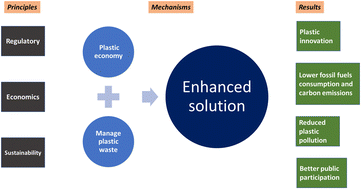
Environ. Sci.: Adv., 2023,2, 1011-1018
https://doi.org/10.1039/D3VA00057E
Cathode regeneration and upcycling of spent LIBs: toward sustainability
Cathode regeneration and upcycling technologies, aimed at non-destructively recovering and upgrading the electrochemical performance of degraded materials, show excellent flexibility and potential for transforming the LIB industry from a resource-based to a circular economy.

Energy Environ. Sci., 2023,16, 2856-2868
https://doi.org/10.1039/D3EE00746D
People, plastic, and behaviour change – a comment on drivers of plastic pollution, barriers to change and targeted behaviour change interventions
Few studies consider human behaviour and relationship impacts on how people use and manage plastic.
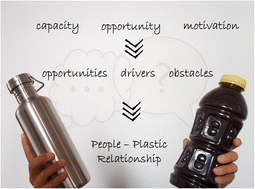
Environ. Sci.: Adv., 2023,2, 551-557
https://doi.org/10.1039/D2VA00248E
Chemistry must respond to the crisis of transgression of planetary boundaries
Chemistry, the science of transformation of matter, is fundamental to achieving sustainability through ensuring biogeochemical flows do not transgress planetary boundaries. This requires urgent changes in chemistry education, research and industry.
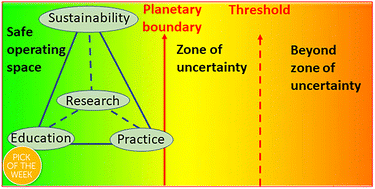
Chem. Sci., 2022,13, 11710-11720
https://doi.org/10.1039/D2SC03603G
Towards circular carbo-chemicals – the metamorphosis of petrochemicals
The petrochemical industry must transition into a circular carbo-chemical industry to respond to three main challenges: shifting hydrocarbon stock, climate change and circular economy.
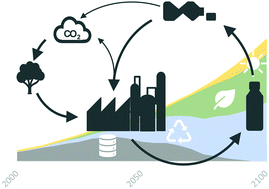
Energy Environ. Sci., 2021,14, 4358-4376
https://doi.org/10.1039/D1EE00532D
Green chemistry and the plastic pollution challenge: towards a circular economy
The solution to plastic pollution is not less chemistry but more, greener chemistry in a circular bio-based economy.
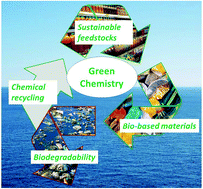
Green Chem., 2020,22, 6310-6322
https://doi.org/10.1039/D0GC02630A
Advances in the use of CO2 as a renewable feedstock for the synthesis of polymers
The most relevant approaches to the construction of polymers by exploiting carbon dioxide as a renewable C1 feedstock are highlighted.
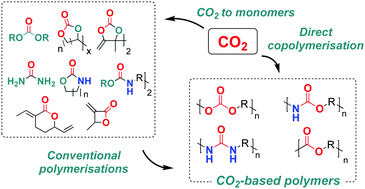
Chem. Soc. Rev., 2019,48, 4466-4514
https://doi.org/10.1039/C9CS00047J
New frontiers in enzyme immobilisation: robust biocatalysts for a circular bio-based economy
This tutorial review focuses on recent advances in technologies for enzyme immobilisation, enabling their cost-effective use in the bio-based economy and continuous processing in general.
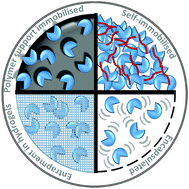
Chem. Soc. Rev., 2021,50, 5850-5862
https://doi.org/10.1039/D1CS00015B
Sustainable design of water–energy–food nexus: a literature review
The water–energy–food nexus aims to achieve sustainable development by meeting present needs while safeguarding the capacity of future generations.

RSC Sustainability, 2023,1, 1332-1353
https://doi.org/10.1039/D3SU00110E
A review on spent lithium-ion battery recycling: from collection to black mass recovery
The advent of lithium-ion battery technology in portable electronic devices and electric vehicle applications results in the generation of millions of hazardous e-wastes that are detrimental to the ecosystem.

RSC Sustainability, 2023,1, 1150-1167
https://doi.org/10.1039/D3SU00086A
Status and advances of deep eutectic solvents for metal separation and recovery
Deep eutectic solvents show interesting prospects as more sustainable alternatives for metal separation and recovery.

Green Chem., 2022,24, 1895-1929
https://doi.org/10.1039/D1GC03851F
Chemically recyclable polymers: a circular economy approach to sustainability
Developing recyclable polymers provides a solution to materials' end-of-life issues and also an approach to establish a circular materials economy.
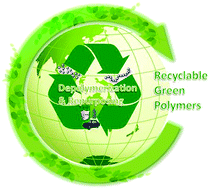
Green Chem., 2017,19, 3692-3706
https://doi.org/10.1039/C7GC01496A
Microbial nanocellulose biotextiles for a circular materials economy
Harnessing microbial biofabrication coupled to a protocol inspired by indigenous textile processes, we engineer high-performance biotextiles with a sustainable circular life cycle, including the plant and mineral dyed bioleather sneakers shown.

Environ. Sci.: Adv., 2022,1, 276-284
https://doi.org/10.1039/D2VA00050D
Polymer up-cycling by mangana-electrocatalytic C(sp3)–H azidation without directing groups
Selective up-cycling of polyolefins to C(sp3)–H azidated materials was achieved by electrocatalysis. The broad scope, ease of scale-up, and late-stage click-diversification are key features.

Chem. Sci., 2023,14, 8109-8118
https://doi.org/10.1039/D3SC02549G
Indirect reduction of CO2 and recycling of polymers by manganese-catalyzed transfer hydrogenation of amides, carbamates, urea derivatives, and polyurethanes
A Mn–PNP complex proved to be a suitable catalyst for the transfer hydrogenation of amides, carbamates, urea derivatives and even polyurethanes.

Chem. Sci., 2021,12, 10590-10597
https://doi.org/10.1039/D1SC02663A
Low-carbon recycling of spent lithium iron phosphate batteries via a hydro-oxygen repair route
Spent lithium iron phosphate batteries can be successfully regenerated via a pollution-free, short-range, and low-carbon hydro-oxygen repair route.

Green Chem., 2023,25, 6642-6651
https://doi.org/10.1039/D3GC00472D
Techno-economic-environmental assessment of the integration of power-to-X and biogas utilization towards the production of electricity, hydrogen, methane and methanol
Various routes for the valorisation of biogas towards methane and methanol and for electricity or hydrogen storage is assessed.

Sustainable Energy Fuels, 2023,7, 2690-2706
https://doi.org/10.1039/D3SE00052D
Bio-based solvents for polyolefin dissolution and membrane fabrication: from plastic waste to value-added materials
Sustainable fabrication of polyolefin membranes from green solvents to application.

Green Chem., 2023,25, 966-977
https://doi.org/10.1039/D2GC03181G
Use of hemicellulose-derived xylose for environmentally sustainable starch production by mixotrophic duckweed
Schematic diagrams of xylose-enriched wastewater treatments and value-added product production by mixotrophic duckweed.
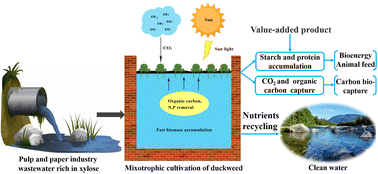
Sustainable Energy Fuels, 2023,7, 641-651
https://doi.org/10.1039/D2SE01186G
Color stability of blue aluminates obtained from recycling and applied as pigments
Aluminates have been used as synthetic inorganic pigments due to their structural stability.
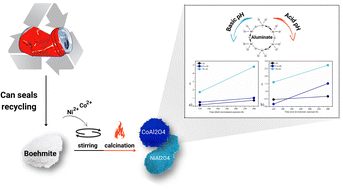
RSC Sustainability, 2023,1, 159-166
https://doi.org/10.1039/D2SU00057A
A recyclable process between a monomer and polyester with a natural catalyst
Catalysts from nature promoted a circular process for polylactide chemistry, including the polymerization of lactide to polylactide, the depolymerization of polylactide to alkyl lactate, and finally the conversion of alkyl lactate back to lactide.
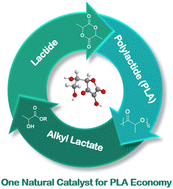
Green Chem., 2022,24, 9282-9289
https://doi.org/10.1039/D2GC03451D
Submerged comminution of lithium-ion batteries in water in inert atmosphere for safe recycling
Lithium-ion batteries are crushed in lime water in an inert N2 atmosphere to inactivate them. N2 flow reduces the risk of hydrogen explosion, and water absorbs the reaction heat.

Energy Adv., 2022,1, 935-940
https://doi.org/10.1039/D2YA00202G
Optimisation of PET glycolysis by applying recyclable heterogeneous organocatalysts
Functionalized silica gels were applied as heterogeneous organocatalysts in PET glycolysis, and were recycled by filtration while preserving high monomer yields over five cycles.
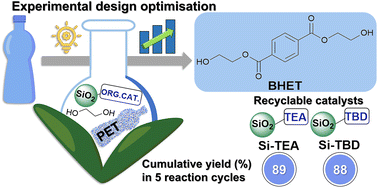
Green Chem., 2022,24, 8447-8459
https://doi.org/10.1039/D2GC02860C
Homoleptic phenoxy-imine pyridine zinc complexes: efficient catalysts for solvent free synthesis and chemical degradation of polyesters
Robust homoleptic zinc catalysts offer new opportunities for recycling polyesters such as poly(lactic acid) and poly(ethylene terephthalate) to obtain platform molecules in a plastics circular economy approach.

Catal. Sci. Technol., 2022,12, 6142-6154
https://doi.org/10.1039/D2CY01092E
Pineapple by-products as a source of bioactive compounds with potential for industrial food application
Characterization of the phenolic profile of the hydroethanolic extracts obtained from pineapple peel and crown leaves, and evaluation of their in vitro bioactivity.

Food Funct., 2022,13, 9959-9972
https://doi.org/10.1039/D2FO00657J
Integrating recyclable polymers into thermoelectric devices for green electronics
Electronic waste (e-waste) recycling is one of the central frameworks of the circular economy.
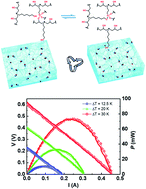
J. Mater. Chem. A, 2022,10, 19787-19796
https://doi.org/10.1039/D2TA00386D
Catalytic reduction and reductive functionalisation of carbon dioxide with waste silicon from solar panel as the reducing agent
Waste silicon wafer recovered from the solar panel production process acted as a reducing agent for reduction and reductive functionalization of CO2 with fluoride catalyst.
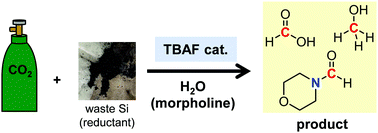
Energy Adv., 2022,1, 385-390
https://doi.org/10.1039/D1YA00077B
Morphological and mechanical characterization of high-strength sulfur composites prepared with variably-sized lignocellulose particles
The extent to which lignocellulose biomass particle size influences the properties of biomass–sulfur composites prepared from these particles was evaluated.

Mater. Adv., 2021,2, 7413-7422
https://doi.org/10.1039/D1MA00689D
Emerging investigator series: thermodynamic and energy analysis of nitrogen and phosphorous recovery from wastewaters
This study quantified the theoretical minimum energy required to recover fertilizer products from different environmental waste streams.
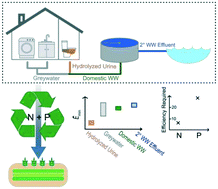
Environ. Sci.: Water Res. Technol., 2021,7, 2075-2088
https://doi.org/10.1039/D1EW00554E
Long-chain polyamide covalent adaptable networks based on renewable ethylene brassylate and disulfide exchange
Long-chain polyamide covalent adaptable networks with high strength and short relaxation times were prepared based on a renewable ethylene brassylate and disulfide exchange.
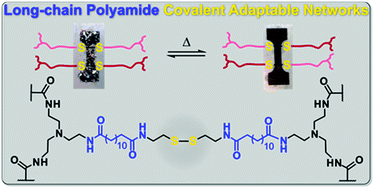
Polym. Chem., 2021,12, 5668-5678
https://doi.org/10.1039/D1PY00811K
Integrated mechanistic engineering models and macroeconomic input–output approach to model physical economy for evaluating the impact of transition to a circular economy
A novel method to standardize and automate material flow/waste mapping in economies by integrating mechanistic engineering models and macroeconomic framework is proposed for identifying pathways to transition towards low carbon/zero waste economy.
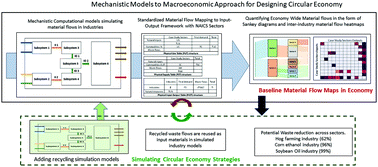
Energy Environ. Sci., 2021,14, 5017-5034
https://doi.org/10.1039/D1EE00544H
Spent coffee waste as a renewable source for the production of sustainable poly(butylene succinate) biocomposites from a circular economy perspective
Spent coffee waste from espresso machines was used as a renewable filler for the melt processing of sustainable poly(butylene succinate) biocomposites with enhanced exploitation properties.

RSC Adv., 2021,11, 18580-18589
https://doi.org/10.1039/D1RA03203H
Direct ink writing of recyclable and in situ repairable photothermal polyurethane for sustainable 3D printing development
Direct ink writing of disulfide-based composites offers a practical approach to customizable and straightforward sustainable 3D printing processes including recycling printing wastes, repairing damaged parts, and reducing processing defects.
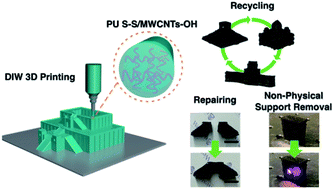
J. Mater. Chem. A, 2021,9, 6981-6992
https://doi.org/10.1039/D0TA11341G
High performance dynamic covalent crosslinked polyacylsemicarbazide composites with self-healing and recycling capabilities
Self-healing and recycling of fiber reinforced polymer (FRP) composites are of great significance towards pursuing a sustainable and circular economy, but remain a huge challenge due to the infusible and insoluble properties of thermoset polymers.

J. Mater. Chem. A, 2021,9, 4055-4065
https://doi.org/10.1039/D0TA11251H
About this collection
The circular economy aims to minimize resource consumption by promoting reuse, refurbishment, and recycling of materials and products. Chemists, and the chemical sciences, have a leading role to play in driving this forward.
This collection of papers from across RSC journals showcases the latest advancements and breakthroughs in topics relating to the circular economy. From enzyme immobilisation for circular bio-based solutions to advancements in using CO2
as a renewable feedstock, and from the recycling of polymers to the upcycling of waste materials, these papers showcase the potential of the chemical sciences to solve the most pressing global challenges.